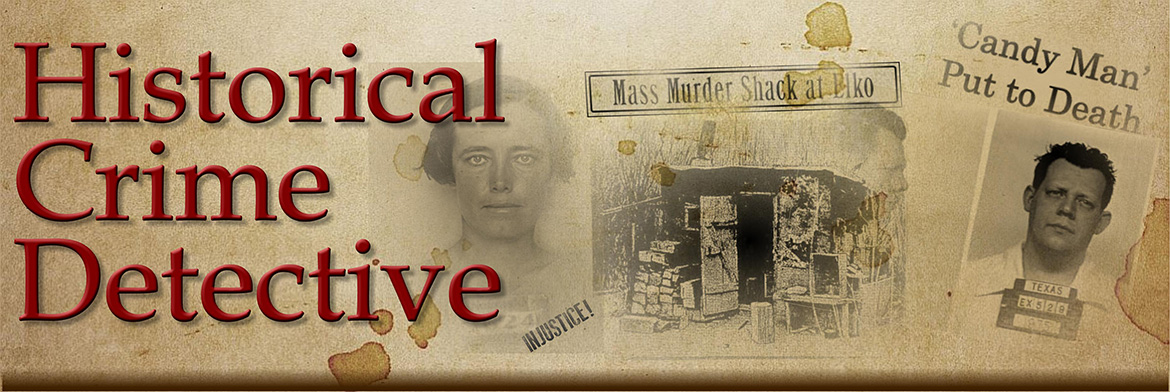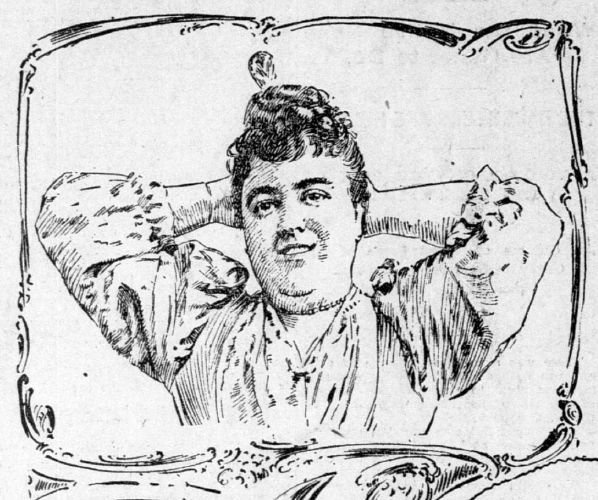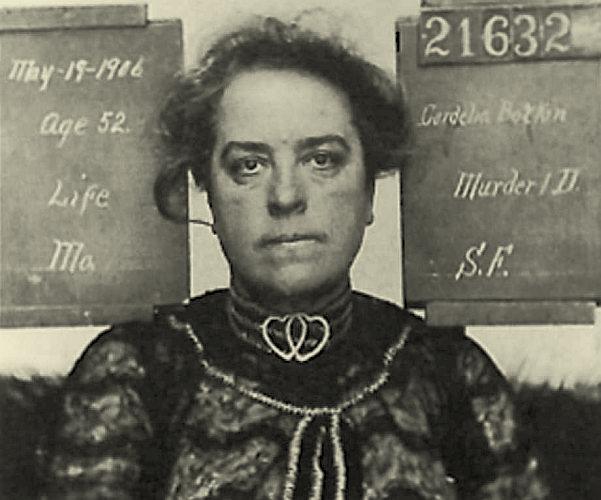Candy From a Stranger: The Cordelia Botkin Case of 1898
Home | Short Feature Story | Candy From a Stranger: The Cordelia Botkin Case of 1898
The following story was written by Thomas Duke in 1910. At the end of the story are links to more articles, a video, and there has even been a movie made recently about this case. The Botkin-Dunning Case was the first time the US Postal Service had been used to commit murder.
On February 12, 1891, John P. Dunning, who became famous as a war correspondent, married Miss Mary Pennington, daughter of ex-Congressman John Pennington, in Dover, Delaware, and the couple came to San Francisco to reside.
The next year a little daughter was born. The family then moved to 2529 California Street, and while living at this address, Dunning took a stroll in Golden Gate Park one afternoon and flirted with a woman sitting on a bench. They entered into a conversation, during which the woman said her name was “Curtis,” and that her husband was in England. After they became more familiar the woman admitted that she was the wife of Welcome A. Botkin, whom she married in Kansas City on September 26, 1872, and that she had a grown son named Beverly. Her maiden name was Cordelia Brown, and the town of Brownsville, Nebraska, was named after her father. Botkin was for many years connected with the Missouri Valley Bank in Kansas City, but lived in Stockton, California, with his son, Beverly, at the time his wife met Dunning. While his wife remained in San Francisco Dunning met Mrs. Botkin clandestinely, but Mrs. Dunning took her baby to her father’s home in Dover, Delaware, and thereafter her husband and Mrs. Botkin were constant companions at the races and cafes.
Mrs. Botkin moved to 927 Geary Street and Dunning took a room in the same building. In the course of conversation he told Mrs. Botkin that his wife was passionately fond of candy and that she had a very dear friend in San Francisco named Mrs. Corbaley.
On March 8, 1898, Dunning accepted a position as war correspondent with the Associated Press, which made it necessary for him to depart immediately for Porto Rico. When he told Mrs. Botkin his plans, she pleaded with him to remain with her. He turned a deaf ear to her pleadings and told her bluntly that he would never return to San Francisco.
She accompanied him across the bay and wept bitterly when they parted.
On August 9, 1898, a small package arrived in Dover, Delaware, addressed to Mrs. John P. Dunning. That package was placed in the mail box belonging to her father, and was called for by Mr. Pennington’s little grandson and taken home.
The family consisted of Mr. and Mrs. Pennington, their two daughters, Mrs. Dunning and Mrs. Joshua Deane ; their son-in-law, Mr. Deane, and the two little children of Mr. and Mrs. Deane.
After supper the family repaired to the veranda, and Mrs. Dunning opened the package, which proved to be a fancy candy box containing a handkerchief, chocolate creams and a small slip of paper on which were the following words:
“With love to yourself and baby.—Mrs. C.”
Mrs. Dunning could not imagine who had sent the package, but being a noble woman, with friends galore, she did not suspect that she had an enemy in the world, and therefore her suspicion was not aroused.
Mrs. Dunning and Mrs. Deane and the latter’s two children partook of the candy, as did also two young ladies, Miss Millington and Miss Bateman, who chanced to pass the Pennington residence while the family were seated on the veranda. During that night all who partook of the candy were taken with retching pains in the stomach and vomited freely.
All recovered with the exception of Mrs. Dunning, who died on August 12, and Mrs. Deane, who died on August 11. Autopsies disclosed the fact that these ladies died from arsenic poisoning.
Mr. Pennington examined the handwriting on the box and on the slip of paper and discovered that it corresponded with the handwriting of an unknown person who had written an anonymous communication from San Francisco to Mrs. Dunning many months previously, in which it was alleged that Mr. Dunning was on intimate terms with a woman in San Francisco. Dr. Wood, a chemist, examined the candy which had not been eaten, and discovered a large amount of arsenic present.
John P. Dunning was advised by telegraph of what had transpired and he proceeded at once to Dover. He immediately recognized the handwriting as that of Mrs. Botkin and recalled his remark to her regarding his wife’s fondness for candy, and also that his wife had a friend in San Francisco named Mrs. Corbaly, which accounted for the initial “C.” signed to the note.
Detective B. J. McVey was sent to San Francisco with the candy, handkerchief, candy box and the note found in the box. Chief of Police I. W. Lees took charge of the case. Mrs. Botkin was located in Stockton, Cal., where she was living with her husband and son. Detective Ed. Gibson brought her to San Francisco, and in a few days an overwhelming amount of circumstantial evidence was piled up against her.
She was positively identified by Miss Sylvia Heney and Miss Kittie Dittmer as the woman who, on July 31, bought candy in the candy store of George Haas under the Phelan block on Market Street. Miss Heney furthermore swore that this woman requested that the candy be placed in a fancy box which did not have the firm’s name on it, and also instructed that the box be not filled completely as she had another article to place in the box.
John P. Dunning produced love letters written to him by Mrs. Botkin, and handwriting expert Theodore Kytka testified to what was obvious to all, namely, that the person who wrote the love letters wrote the address on the candy box and the note therein.
Mrs. Botkin even neglected to remove the store tag from the handkerchief which she purchased in the “City of Paris” store from Mrs. Grace Harris, who even recalled the conversation she held with Mrs. Botkin. When asked why she recalled this so clearly, she stated that Mrs. Botkin’s resemblance to her dead mother startled her. She subsequently produced a photograph of her mother to show the striking resemblance.
Frank Grey, a druggist employed at the “Owl” drug store, positively identified Mrs. Botkin as the woman who had pur-chased two ounces of arsenic for the alleged purpose of bleaching a straw hat, and insisted upon getting this drug even when the druggist informed her that there were other preparations better adapted for the purpose.
On August 4 the package of candy was mailed at the Ferry Post Office and was particularly noticed by a postal clerk named John Dunnigan because the address, “Mrs. John Dunning,” reminded him of his own name. On this same day Mrs. Botkin left San Francisco for St. Helena.
Mrs. Almura Ruoff related a conversation she had with Mrs. Botkin in Stockton on July 27, 1898, in which the latter made inquiries as to the effect of different poisons on the human system, and asked if it was necessary to sign one’s name when sending a registered package through the mail.
After Mrs. Botkin left the Hotel Victoria at Hyde and California streets, where she had been stopping some months, W. P. Rossello, a porter, and W. W. Barnes, a clerk, found a torn piece of a gilded seal, similar to those pasted on candy boxes, on the floor of room 26, which Mrs. Botkin vacated. It was proved that the seal came from Haas’ store and the wrapping on the candy box clearly showed where it had been removed.
Extradition papers were forwarded from Delaware as it was planned to take her there for trial, but her attorney, George Knight, attempted to procure her release on the grounds that the evidence was insufficient, and furthermore, that the jurisdiction for the trial was in California and not Delaware.
Superior Judges Cook, Borden, Wallace, Troutt and Seawell, sitting en banc, rendered a decision on October 23 to the effect that the jurisdiction for the trial was in California, as Mrs. Botkin’s flight from Delaware was not actual but constructive. This decision was upheld by the Supreme Court.
The evidence was presented to the Grand Jury and on October 28, 1898, Mrs. Botkin was indicted. On December 9, 1898, the trial for the murder of Mrs. Dunning began.
On December 19, while testifying in the case, John P. Dunning refused to mention the names of other women he had been intimate with, and he was adjudged guilty of contempt and sent to jail, where he remained for several days until the question was withdrawn.
On December 30, 1898, Mrs. Botkin was found guilty and on February 4, 1899, she was sentenced to life imprisonment.
On March 9 Mrs. Botkin’s husband, Welcome A. Botkin, sued her for a divorce on the grounds that she had been convicted of a felony.
Before Mrs. Botkin could be sent to State prison, a decision was rendered by the State Supreme Court in the case of “Albert Hoff,” who murdered Mrs. Clute on Guerrero street, wherein it was decided that the trial Judge erred when, in his charge to the jury, he stated that “circumstantial evidence has the advantage over direct evidence, because it is not likely to be fabricated.” It was held that by so doing he expressed to the jury his opinion upon the force and effect of the testimony and intimated his views of its sufficiency. As the same form of charge was delivered in the Botkin and numerous other cases, she experienced no difficulty in obtaining a new trial.
This necessitated the bringing of all the Delaware witnesses back to San Francisco. The second trial also resulted in a verdict of guilty and on August 2, 1904, she was again sentenced to life imprisonment, which judgment was affirmed by the State Supreme Court on October 29, 1908.
After the conviction of Mrs. Botkin she was confined in the Branch County Jail, pending the decision from the higher court.
About this time Superior Judge Cook lost his wife and each Sunday he visited her grave, riding out on a car which passed the jail. On one Sunday he was astonished at seeing Cordelia Botkin in the same car and apparently unguarded. The murderess signaled the car to stop at the county jail and she proceeded in the direction of that institution, but was lost to the Judge’s view, as he remained on the car.
The next day he instituted an investigation.
It was charged that the voluptuous woman was on intimate terms with one or more of the guards, which accounted for the fact that she was surrounded with every comfort at the jail. It was also charged that she was probably accompanied on the pleasure trip by a friendly guard who was on another part of the car.
Judge Cook failed to find anyone connected with the jail who would admit that the prisoner had been away from the building on Sunday, and the woman attempted to take advantage of the situation by claiming that the person who resembled her so much that the trial judge was mistaken, was probably the person who purchased the arsenic, candy and handkerchief, but the claim was not seriously considered.
After the great earthquake and fire the branch county jail, where Mrs. Botkin was confined, became crowded because of the destruction of the main jail, and as a result this woman lost the comfortable quarters she had enjoyed for years.
Although the Supreme Court had not yet reached a decision in her case, she made application to be transferred to San Quentin State Prison, and the request was complied with on May 16, 1906.
After her conviction her erstwhile lover, her mother, sister, son, and also her former husband, died within a short time.
The prisoner became a victim of nervous prostration and was soon a physical wreck. During the latter part of 1909 she began to suffer from melancholy. In February, 1910, she applied for parole because of her health, but it was decided that she was not eligible.
On March 7, 1910, she became unconscious and died. The death certificate shows that she died from “softening of the brain, due to melancholy.”
She was 56 years old at the time of her death.
From the book: “Celebrated Criminal Cases of America,” by Thomas Samuel Duke, The James H. Barry Company, 1910.
Video
More Reading:
San Francisco Gate: Murder by mail: The story of San Francisco’s most infamous female poisoner
Movie Trailer: The Mischievous Case of Cordelia Botkin, – youtube.com
—###—
True Crime Book: Famous Crimes the World Forgot Vol II, 384 pages, Kindle just $3.99, More Amazing True Crime Stories You Never Knew About! = GOLD MEDAL WINNER, True Crime Category, 2018 Independent Publisher Awards.
---
Check Out These Popular Stories on Historical Crime Detective
Posted: Jason Lucky Morrow - Writer/Founder/Editor, December 9th, 2013 under Short Feature Story.
Tags: 1800s, Murder, Poison, Women























